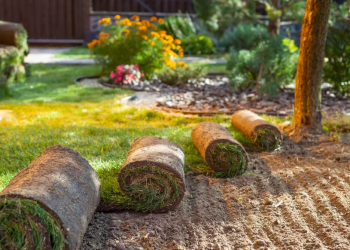Early spring or late autumn are the best times of the year to build a fence. This is because any plants that would have been destroyed by the new structure will have more time to recover before the summer peak period.
Pre-Project Planning
Before you start your fencing project there are a few things you need to do. Discuss your plans with your neighbor if the fence is next to their property. Also, check for the exact boundary lines to ensure you’re not encroaching.
Depending on the height of your fence, you might need planning permission. If it’s less than 2m, you’re fine. However, check your boundary lines meet with local authority requirements.
Erecting the Fence
1. Start with a straight line. Fix a wooden stake to the ground at the beginning point of the fence, tie a string to it and pull it out tight and extend it until you can wrap it around another stake at the other end of the area.
2. Dig a 600mm deep hole at the starting point of the fence. Use a width the size of a garden spade. This allows you enough room for the post as well as the concrete that’ll be securing it.
3. With a tape measure or gravel board, mark out a position for the remaining post holes. The gravel board has the same width as a fence panel and allows for a quick form of measurement.
4. Repeat Step 2 to dig the remaining post holes.
5. Add extra protection for the area of the post that’ll be sitting in the ground. Use a brush to add some coats of bitumen-based paint to all sides and base of the post.
6. While the paint dries, drill four equally-spaced pilot holes on the sidebars on both sides of the fence panels.
7. One great tip is to add a gravel board to the foot of the panel to prevent the end grain from touching the ground and potentially absorbing moisture. The gravel board should be positioned just-above the bitumen-painted area of the post.
Bore a pilot hole diagonally into the edge of the board and in the post on both sides, then use some screws to hold the board.
For hard surfaces like concrete, allow a gap of 5mm between the fence panel or gravel board’s base and the ground. This way, water can wash beneath, instead of soaking the wood.
8. Attach the panel to both sides of a post by fixing screws through the pilot holes from Step 6.
9. Carry the fence panel into position and put the posts in the holes. Prop up the panel into position using a length of batten placed diagonally from ground to top of panel.
10. Form a neat hook by fixing a screw at the top of the batten. This prevents the panel from moving backwards or forwards.
11. With a spirit level, check that the fence panel is level through the top and that the posts are vertical. Adjust if needed. You can add some rubble to each hole to ensure the posts remain vertical.
12. Once the first panel is secure, fix a post to an edge of the next panel and lower both post and panel into position. Follow steps 9 to 10 to secure the panel, then check for level. Now screw the new panel to the post. Add some rubble to the hole, then repeat this step until all the panels are in position.
13. Once the panels are in place, check for the level to ensure all posts are vertical, then concrete in the fence posts. Use ready-mixed, quick-setting ‘post mix’ for this purpose.
14. Add water to the hole and push down to create a stiff mix. Keep this mix just below natural ground level so you can cover the set concrete with turf or earth later on.
If you want full details on the installation of a fence, the costs, with a cost calculator to help you plan, read more on how to install a fence.








